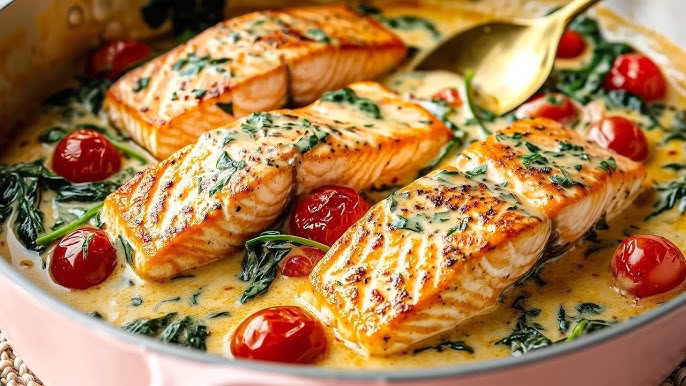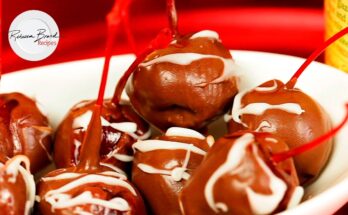Roasted Salmon Recipe: Few meals are as satisfying, flavorful, and impressively simple as roasted salmon. Whether you’re preparing dinner for yourself, your family, or guests, this dish delivers a perfect balance of nutrition, elegance, and taste.
The beauty of roasting salmon lies in its versatility—you can go classic with lemon and herbs, or spice things up with bold glazes and seasonings.
Let’s dive deep into this complete, step-by-step guide to mastering roasted salmon at home.
Why Roasted Salmon is a Favorite Dish
Roasted salmon has earned its place as a go-to meal in many kitchens—and it’s not hard to see why. First of all, it’s fast. You can go from fridge to dinner table in under 30 minutes. Second, it’s easy. Even if you’re new to cooking, salmon doesn’t require complicated techniques. Third, and most importantly, it tastes amazing. When roasted correctly, salmon turns juicy and flaky with a golden, crispy edge that’s hard to resist.
There’s also a high level of flexibility. Want a light, lemony profile? Add citrus and herbs. Prefer something rich and bold? A miso or garlic butter glaze will do the trick. You can adapt this one dish to your flavor preferences without changing the basic cooking technique.
Plus, salmon feels special. Whether for weeknight dinners or special occasions, it always feels like a treat—one that doesn’t take hours to prepare or break the bank.
Nutritional Benefits of Salmon
Beyond taste and convenience, salmon is a nutritional powerhouse. It’s packed with high-quality protein, making it perfect for muscle recovery and satiety. But what really sets salmon apart is its omega-3 fatty acid content—these healthy fats support heart health, brain function, and can even reduce inflammation.
Salmon is also a great source of:
- Vitamin B12 (essential for energy and red blood cell production)
- Vitamin D (important for bone health)
- Selenium (an antioxidant that helps protect cells)
- Potassium (for muscle function and blood pressure control)
With such an impressive profile, roasted salmon makes it easy to eat well without sacrificing flavor. Whether you’re aiming to lose weight, build muscle, or simply enjoy a wholesome meal, this dish checks all the boxes.
Ingredients You’ll Need
Main Ingredients for Roasted Salmon
Here’s what you’ll need to make a classic, no-fuss roasted salmon:
- Salmon fillets (preferably skin-on, around 6 oz each)
- Olive oil (or melted butter for a richer flavor)
- Lemon (zest and juice for brightness)
- Garlic (minced or grated)
- Salt (sea salt or kosher salt works best)
- Black pepper (freshly cracked)
- Fresh herbs (like parsley, dill, or thyme)
These simple ingredients form the foundation of a flavorful roasted salmon dish. If you keep your pantry stocked with them, you’re always minutes away from a delicious meal.
Optional Add-ons and Variations
To take your roasted salmon to the next level, consider these optional ingredients:
- Honey or maple syrup – for a touch of sweetness
- Soy sauce or tamari – adds umami and saltiness
- Paprika or cayenne pepper – for a mild kick
- Miso paste – for deep, savory flavor
- Mustard (Dijon or whole grain) – adds sharpness and complexity
- Capers or olives – salty contrast to the rich salmon
You can mix and match these to create your own signature seasoning or glaze. Don’t be afraid to experiment—it’s hard to go wrong with salmon.
Recommended Kitchen Tools
While you don’t need any fancy equipment to roast salmon, having the right tools can make things easier:
- Baking sheet (lined with parchment paper or foil for easy cleanup)
- Instant-read thermometer (to ensure perfect doneness)
- Brush (for applying marinades or glazes)
- Sharp knife (for slicing lemon or herbs)
- Fish spatula (helps lift delicate fillets without breaking them)
With these basics in your kitchen, roasting salmon becomes even more convenient and stress-free.
Preparation Steps Before Cooking
Choosing the Right Salmon
Your roasted salmon is only as good as the fish you start with. Here’s how to choose the best:
- Fresh vs. frozen: Both can be excellent if handled correctly. Fresh salmon should smell clean (like the ocean) and appear moist, not slimy. Frozen is great too—just make sure it’s wild-caught or sustainably farmed and thawed safely in the fridge.
- Farmed vs. wild-caught: Wild salmon tends to have a more intense flavor and firmer texture, while farmed salmon is milder and fattier. Both work well—go with your taste and budget.
- Skin-on vs. skinless: Skin-on fillets are easier to handle and stay moist while roasting. Plus, crispy salmon skin is a treat on its own.
Choosing high-quality salmon sets the tone for your dish—don’t skimp on this step.
Cleaning and Prepping the Fish
Once you have your salmon, give it a quick prep:
- Rinse (optional): If there’s visible residue, rinse it under cold water and pat completely dry with paper towels.
- Pin bones: Run your fingers along the flesh to feel for tiny bones. Remove them with tweezers.
- Trim: Remove any excess fatty bits or thin parts that might overcook.
- Portion: If you’re working with a large fillet, slice it into even-sized portions for uniform cooking.
This simple prep ensures even cooking and a more pleasant eating experience.
Prepping the Marinade or Seasoning
Here’s a quick classic marinade that works every time:
- 2 tablespoons olive oil
- Juice of half a lemon
- 2 garlic cloves, minced
- Salt and pepper to taste
- Fresh herbs, chopped (dill or parsley)
Whisk it all together and pour over the salmon, letting it sit for 10–15 minutes while the oven preheats. This gives the flavors time to meld without turning the fish mushy.
Step-by-Step Guide to Roasting Salmon
Step 1: Preheat Your Oven
Begin by preheating your oven to 400°F (200°C). Line a baking sheet with parchment paper or foil for easy cleanup. A hot oven ensures the salmon roasts evenly, locking in moisture while giving it that perfectly flaky texture.
Step 2: Seasoning the Salmon
Place your salmon fillets skin-side down on the prepared baking sheet. Brush lightly with olive oil or melted butter, then season with salt, black pepper, and a squeeze of fresh lemon juice. For extra flavor, you can sprinkle minced garlic, dill, or paprika—or lay lemon slices right on top. Simple, clean seasoning lets the natural flavor of the salmon shine.
Step 3: Roasting Time and Temperature
Roast the salmon in the preheated oven for 10–15 minutes, depending on the thickness of your fillets. A general rule: cook for about 10 minutes per inch of thickness. Avoid overcooking—salmon continues to cook slightly even after it’s removed from the oven.
Step 4: Checking for Doneness
You’ll know the salmon is perfectly roasted when it flakes easily with a fork and the flesh turns opaque pink throughout. If you have a food thermometer, the internal temperature should read 145°F (63°C) at the thickest part.
Step 5: Letting It Rest
Remove the salmon from the oven and let it rest for 3–5 minutes before serving. This helps the juices redistribute, keeping every bite moist and tender. Serve with a drizzle of lemon butter, a sprinkle of herbs, or a side of roasted vegetables for a wholesome, elegant meal.
Serving Suggestions
Ideal Side Dishes to Pair With Roasted Salmon
Roasted salmon is delicious on its own, but pairing it with the right side dishes takes your meal to the next level. You want sides that complement its richness and balance the flavors.
Here are some amazing combos:
Vegetables
- Roasted asparagus with garlic and lemon
- Sautéed spinach with olive oil and a hint of chili
- Grilled zucchini or eggplant with herbs
- Brussels sprouts with balsamic glaze
Starches
- Garlic mashed potatoes or cauliflower mash for a creamy contrast
- Steamed rice or wild rice for a nutty texture
- Quinoa salad with cucumber, feta, and herbs
- Crispy roasted baby potatoes tossed in rosemary
Salads
- Arugula salad with lemon vinaigrette
- Greek salad with tomatoes, olives, and red onion
- Cucumber dill salad for something cool and crunchy
Mix and match your sides to suit the occasion. A light green salad and grilled vegetables work great for a weeknight meal, while mashed potatoes and roasted carrots feel more indulgent for a dinner party.
Also, don’t forget a good sauce. Try:
- Lemon dill yogurt sauce
- Honey mustard drizzle
- Garlic herb butter
- Pesto (basil or sun-dried tomato)
These finishing touches add personality and depth to the dish.
Tips for Perfectly Roasted Salmon
Avoiding Common Mistakes
Even though roasting salmon is simple, there are a few easy mistakes that can ruin an otherwise perfect meal. Let’s walk through the biggest pitfalls and how to avoid them:
1. Overcooking
This is hands-down the most common issue. Salmon doesn’t need a long time in the oven. Overcooking results in dry, rubbery fish that’s a far cry from the juicy, flaky texture you want. Remember to follow the time and temperature guide—and trust your thermometer!
2. Using wet salmon
If you don’t pat the fish dry before roasting, you’ll miss out on that lovely crust. Moisture on the surface causes the fish to steam instead of roast. Always blot with a paper towel first.
3. Not seasoning enough
Salmon has a bold flavor, but it still needs seasoning. Be generous with salt, pepper, and whatever other herbs or spices you choose. A bland fish is a sad fish.
4. Skipping the rest
Pulling salmon straight from the oven to the plate can cause juices to escape too quickly. Letting it rest—even for just 5 minutes—makes a world of difference.
5. Baking skin-side up
Always roast with the skin-side down. It helps insulate the fish and keeps it juicy. Plus, it crisps up beautifully if you finish under the broiler.
Avoiding these mistakes will elevate your salmon game from decent to restaurant-worthy.
Enhancing Flavor with Herbs and Citrus
Want to turn your roasted salmon from great to unforgettable? Let’s talk herbs and citrus—the ultimate flavor enhancers.
Herbs to use:
- Dill: Fresh, grassy, and slightly tangy. Pairs beautifully with lemon.
- Parsley: Bright and clean, it’s the perfect finishing touch.
- Thyme: Earthy and warm, especially good for fall-inspired dishes.
- Basil: Sweet and peppery—use it with tomato-based toppings.
- Cilantro: Bold and citrusy, great in Latin or Asian-inspired salmon.
Chop herbs finely and scatter them over the top after roasting, or mix them into a quick sauce.
Citrus boosts:
- Lemon slices under or on top of the salmon infuse the fish with freshness.
- Zest (from lemon, lime, or orange) adds concentrated citrus oils.
- Juice balances richness and adds tangy brightness.
Try this: Combine lemon zest, fresh dill, olive oil, and garlic for a simple but unforgettable salmon rub. It tastes like something from a five-star bistro—but it’s totally doable in your kitchen.
Variations of Roasted Salmon Recipes
Garlic Butter Roasted Salmon
This version is decadent, rich, and bursting with savory flavor. The garlic butter melts into the salmon as it roasts, creating a golden, flavorful crust.
Ingredients:
- 4 tbsp unsalted butter, melted
- 3 garlic cloves, minced
- 1 tbsp fresh parsley
- ½ lemon, juiced
- Salt and pepper
Brush this mixture over the salmon before roasting. For extra depth, add a pinch of paprika or smoked salt.
Honey Glazed Roasted Salmon
Sweet, sticky, and slightly caramelized—this recipe adds a whole new level of flavor to your salmon. The sugars in the honey help create a golden glaze, while balancing the natural richness of the fish.
Ingredients:
- 2 tbsp honey
- 1 tbsp soy sauce
- 1 tsp Dijon mustard
- 1 garlic clove, grated
- 1 tsp lemon juice
Whisk together and brush onto the salmon. Roast as usual, and optionally broil for 2 minutes at the end to caramelize the glaze.
Spicy Cajun Roasted Salmon
Craving something bold? This spicy, smoky variation delivers. It’s the perfect salmon twist for fans of heat.
Cajun spice blend:
- 1 tsp smoked paprika
- ½ tsp cayenne pepper
- 1 tsp garlic powder
- ½ tsp onion powder
- ½ tsp oregano
- Salt and black pepper to taste
Rub the seasoning onto the fish with olive oil, then roast. Serve with avocado or lime crema to cool the heat.
Storing and Reheating Leftover Salmon
Best Practices for Storage
Roasted salmon is just as good the next day—if you store it properly. Here’s how to keep it fresh and flavorful:
Fridge:
- Store in an airtight container.
- Keeps well for up to 3 days.
- Keep the skin on to help retain moisture.
Freezer:
- Wrap individual fillets tightly in plastic wrap or foil.
- Place in a zip-top freezer bag or airtight container.
- Freeze for up to 2 months.
- Thaw overnight in the fridge before reheating.
Avoid leaving salmon at room temperature for more than 2 hours to prevent bacterial growth.
How to Reheat Without Drying It Out
The key to reheating salmon is low and slow. Microwaving at full power is a sure way to dry it out and ruin the texture.
Best methods:
Oven:
- Preheat to 275°F (135°C).
- Place salmon in a baking dish with a splash of water or lemon juice.
- Cover with foil and heat for 15 minutes, or until warmed through.
Stovetop:
- Heat a skillet over low heat.
- Add a little oil or butter.
- Warm the salmon gently, flipping once.
Microwave (last resort):
- Place in a microwave-safe dish.
- Cover with a damp paper towel.
- Use 50% power and heat in 30-second bursts until just warm.
You can also flake leftover salmon into salads, pasta, or wraps—it’s incredibly versatile.
Health and Dietary Considerations
Is Roasted Salmon Keto-Friendly?
Absolutely! Roasted salmon is naturally high in protein and healthy fats, with zero carbs—making it perfect for a keto or low-carb diet.
Pair it with:
- Steamed broccoli and garlic butter
- Zucchini noodles (zoodles)
- Cauliflower rice
- Spinach salad with olive oil dressing
For added fat, use compound butter or a creamy herb sauce.
Adjusting the Recipe for Allergies
Here’s how to make roasted salmon safe and enjoyable for everyone:
Dairy-Free:
- Use olive oil instead of butter.
- Skip creamy sauces—go for citrus-based or vinegar-based marinades.
Gluten-Free:
- Avoid soy sauce (contains gluten). Use tamari or coconut aminos instead.
Nut-Free:
- Most salmon recipes are naturally nut-free, but always double-check sauces and seasonings.
Low-Sodium:
- Skip added salt or use lemon, herbs, and spices to boost flavor without sodium.
- Choose low-sodium soy sauce if using.
Whether you’re cooking for a picky eater or someone with dietary needs, roasted salmon can be easily tailored to suit all kinds of diets.
FAQs about Roasted Salmon Recipe
1. Can I use frozen salmon?
Yes, just thaw it in the fridge overnight before cooking. Pat dry well to remove excess moisture.
2. How do I know when salmon is done roasting?
It should be opaque, flake easily with a fork, and reach 125°F internally.
3. What’s the best internal temperature for cooked salmon?
125°F (52°C) for medium; 135°F (57°C) for well-done. Use a food thermometer for accuracy.
4. Can I roast salmon with the skin on?
Absolutely! Skin-on helps retain moisture and adds texture. Place it skin-side down while roasting.
5. What herbs go best with roasted salmon?
Dill, parsley, thyme, basil, and cilantro all complement salmon beautifully. Mix and match to suit your taste.
Conclusion
Roasting salmon at home isn’t just easy—it’s rewarding. From its incredible flavor and health benefits to its versatility and elegance, roasted salmon is a must-have recipe in your kitchen arsenal. With the right ingredients, tools, and techniques, you can go from a basic dinner to a restaurant-level experience in less than 30 minutes.
Whether you’re sticking with a classic lemon-herb combo or branching into bold glazes and spicy rubs, roasted salmon is a blank canvas for your culinary creativity. Try it once, and it just might become your new favorite weeknight meal.



